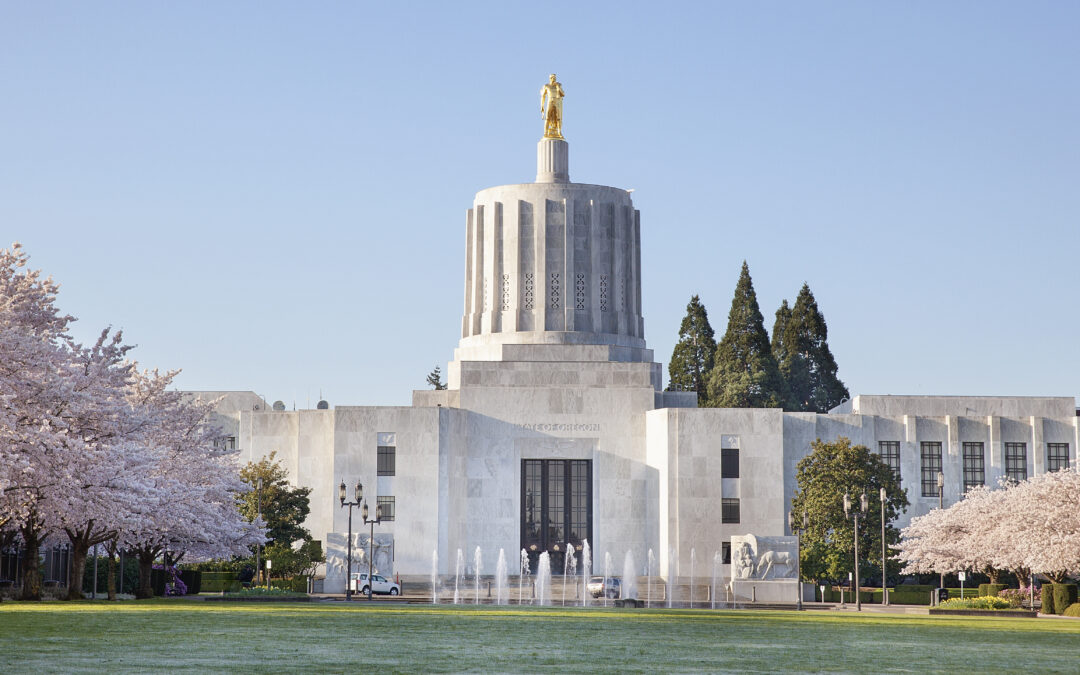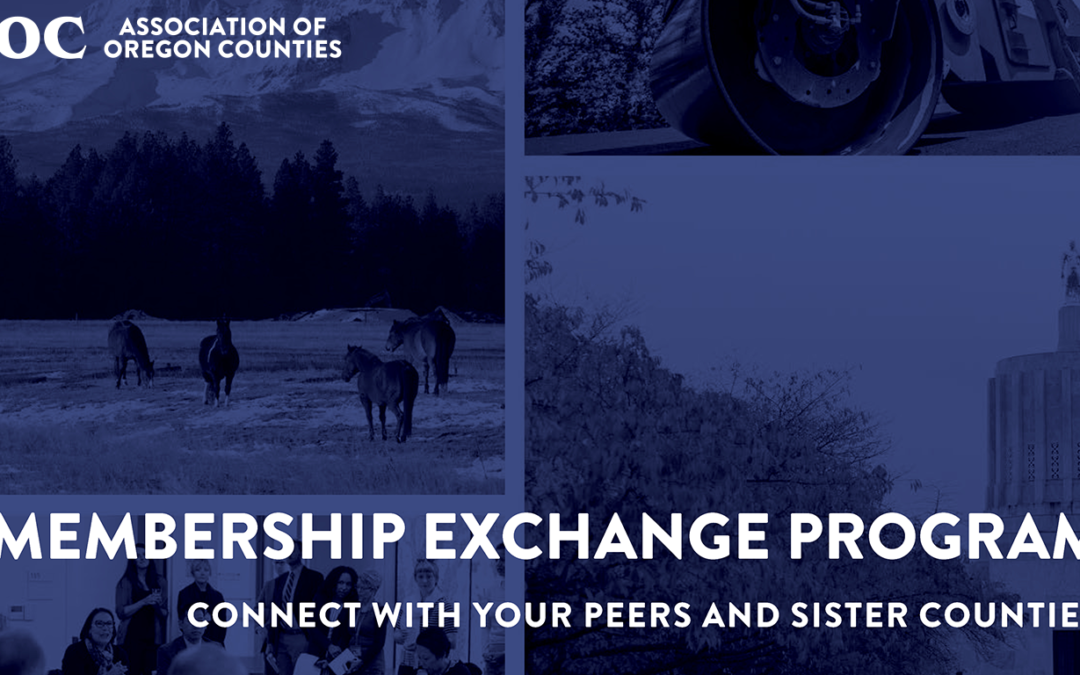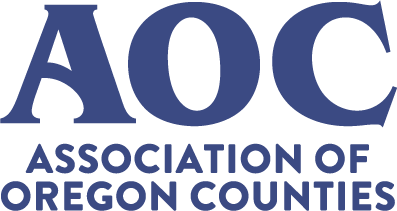
May 28, 2024 | AOC Advocacy, AOC News
The Association of Oregon Counties (AOC) policy steering committees and the Legislative Committee will meet June 17-18, in Salem, to consider and adopt the policy priority platform for Oregon’s 2025 legislative session. AOC’s priority policy items represent pressing issues with a strong nexus to county budgets, services, and functions that unite all Oregon counties.
Since the legislature adjourned sine die in March, AOC steering committees have met for nearly 40 hours of collective deep-dive information gathering and dialogue in preparation for the priority setting meetings. AOC steering committee co-chairs invited stakeholders, AOC affiliate and associate organizations, governor’s office representatives, and state agency directors and staff for presentations and in-depth Q&A sessions.
The AOC Legislative Committee adopts official positions on policy proposals, principles, and biennial priorities as recommended by AOC steering committees and thereby directs the legislative activities of the executive director and AOC legislative affairs team. Membership of the AOC Legislative Committee includes the AOC Board of Directors, one additional member from each of the eight AOC districts, the chair and vice chair of each AOC steering committee, one district attorney designated by the Oregon District Attorneys Association, and any additional members that the board of directors choose to appoint, such as a county not otherwise represented. Action is taken with 67% approval of voters present.
AOC steering committees analyze policy proposals, formulate policy solutions, discuss best practices, and advise the AOC legislative committee on policy positions, policy principles, and biennial priorities. Steering committees are co-chaired by county commissioners appointed every year by the AOC President and meetings are open to all AOC members. Every AOC member present at an AOC steering committee meeting can vote on action items and help shape AOC’s policy platform.
AOC steering committee recordings, agendas, and supplemental materials can be found on the AOC website within each policy portfolio:
Contributed by: Mallorie Roberts | Legislative Affairs Director

May 28, 2024 | AOC News
The Association of Oregon Counties (AOC) is excited to announce that applications will open for the 2024-25 AOC Membership Exchange Program on June 10.
The application process includes a quick, five-minute survey to help identify which counties you are interested in learning more about and what you hope to share about your county with your colleagues. Based on the application information, applicants will be placed in pairs or small groups and encouraged to plan county visits to get on-the-ground exposure to county successes, projects, and programs across diverse geographic regions and county structures.
Introduced in 2021 by the AOC Membership Committee, the AOC Membership Exchange Program was created to support AOC’s purpose to unite and advance county issues, foster trust in county government, and develop programs and services that support the success of counties into the future. Since inception, over 25 participants representing 20 counties, have planned exchange visits across the state.
Learn more about the program timeline on the program’s webpage. The application portal will open on Monday, June 10, and close on Friday, July 12, at 12 a.m. (midnight) PDT.
Contributed by: Kristen Paul | Member Services and Education Director

Mar 29, 2024 | AOC Advocacy, AOC News, Health & Human Services
This year’s short legislative session was remarkably successful, as the Association of Oregon Counties (AOC)’s health and human services priorities largely aligned with those of legislators on both sides of the aisle. The following policy and funding bills, effective upon the governor’s signature, will better equip counties to address the state’s dual homelessness and substance abuse crises.
HB 4092 addresses AOC’s top health and human services policy priority, and requires a mandatory cost study to be conducted every five years for services that our community mental health programs are statutorily mandated to provide. The study is aimed to capture the true cost of the service delivery array, correcting for inflation-based increases as well as unfunded mandates. The first study is due in December 2024 and because of the short timeframe, will be limited to court-mandated services. A full study will be conducted in 2025.
HB 4092 also mandates and funds a workgroup to recommend measures to reduce the administrative burden on community mental health programs and their local contracted providers. The report is due at the end of the year. A survey of local providers estimates that 40% to 60% of every clinician’s day is spent on administrative work rather than direct care. Any reduction in this burden will immediately increase Oregon’s public behavioral health services capacity.
HB 4002 (Measure 110 reform policy bill) establishes local jail-based and mobile medication for opioid use disorder programs through grants from the Criminal Justice Commission. The bill requires at least 10% of total grant awards to be awarded to facilities in rural areas.
HB 5204 (omnibus funding bill for Measure 110 reform and related programs) provides:
- Gap funding for specialty courts, aid and assist community restoration services, and jail diversion
- Start-up funding for county deflection (pre-arrest diversion) programs
- Start-up funding for the medication for opioid use disorder program
- Behavioral health workforce development funding at Oregon universities to attract and support students acquiring degrees and certifications
HB 4001 establishes an interim task force that will recommend specialty court system improvements and sustainability measures for consideration in the 2025 session. There are two seats on the task force for county government.
Contributed by: Legislative Affairs Manager Jessica Pratt

Mar 29, 2024 | AOC Advocacy, AOC News
On Wednesday, March 27, Governor Kotek signed SB 1576, which contained a “recreational immunity” fix eliminating the excessive liability that was causing local governments across Oregon to close off public access to trails on their land. With the governor’s signature, the law has now become effective, meaning that “NO ACCESS” signs can be taken down immediately. The Association of Oregon Counties (AOC), together with the Oregon Recreation and Parks Association, the League of Cities, the Special Districts Association of Oregon, the Oregon School Boards Association, and many other public landowners, worked hard to persuade the legislature to enact this legislation.
The new protections only last through the end of 2025, so another bill will have to be passed during the 2025 legislative session to preserve the protections. AOC expects to continue participating in the Coalition to Restore Recreational Immunity as efforts to get a permanent fix continue.
Citycounty Insurance Services (CIS) had issued guidance encouraging trails be closed because of the liability risk arising out of the Fields v. City of Newport case, where court rulings severely curtailed the landowner protections recreational immunity law provides. CIS is updating its Recreational Immunity FAQ page to reflect the fact that the excessive liability around public access to trails is gone.
In a message to its clients, CIS wrote: “Because SB 1576 went into effect immediately, all trails that were previously closed due to the Fields v. City of Newport court decision can now be reopened without undue risk to local government budgets and programs. CIS is very happy to encourage local governments throughout Oregon to let their constituents know that all trails and recreational opportunities are open for business once again, and will remain open throughout the summer season.”
CIS General Counsel Kirk Mylander will be joining AOC’s Governance, Revenue, and Economic Development Steering Committee meeting on April 12, to review the new law and answer questions from county representatives. A recording of the meeting will be made available here.
Contributed by: Legislative Affairs Manager Michael Burdick

Mar 27, 2024 | AOC Advocacy, AOC News, Health & Human Services, Public Safety & Veterans
The short, fast-paced 2024 legislative session ended with real wins for the Association of Oregon Counties (AOC) public safety portfolio. AOC’s Public Safety Steering Committee identified two priorities in advance of the session — increasing state investment in community corrections for the remainder of the 23-25 biennium, and elevating the county voice and role in Ballot Measure 110 reform conversations. Both of these priorities were achieved due to the ongoing advocacy of AOC members.
Community corrections funding
This past fall AOC heard from counties across the state that funding for community corrections was at a critical breaking point. In response, the AOC Public Safety Steering Committee prioritized increased state investments in community corrections funding for the remainder of the 23-25 biennium in the 2024 short session.
Thanks to advocacy from AOC members and community corrections directors, the legislature recognized this critical need and appropriated the requested amount. HB 5204 includes $16 million allocated to the Oregon Department of Corrections for grant-in-aid funding to counties specific to community corrections funding. AOC and other partners have committed to coming to the table over the interim to collaborate on a new funding formula for community corrections, ensuring that future funding formulas are better reflective of current populations coming through community corrections.
Addressing the fentanyl crisis
In addition to community corrections needs, the AOC Public Safety Steering Committee also prioritized Measure 110 reforms in the 2024 legislative session. Specifically, our members asked AOC to elevate the county voice in Measure 110 reform, supporting policy modifications that prioritize engagement in substance abuse treatment, provide sufficient funding for county services, and strengthen tools the criminal justice system can use to fight illegal drug use and sales.
The legislature passed two bills related to Measure 110 reform — House Bill 4002: Measure 110 Reform Policy Package, and House Bill 5204: Measure 110 Reform Funding Package.
AOC staff worked closely throughout session with public safety partners and legislative leadership consistently communicating how potential Measure 110-related policy changes would affect counties. AOC staff advocated for appropriate funds and capacity building at counties, while also pushing for maintaining the integrity of counties’ local mental health authority. AOC President Danielle Bethell testified on behalf of AOC in front of the Joint Committee on Addiction and Community Safety Response during a public hearing on HB 4002 and relayed AOC’s position, which was also submitted as written testimony. AOC is grateful to our members, partners, and the legislature for passing meaningful legislation and centering counties in the policy development process and policy implementation. View a comparison of AOC adopted principles with the final bill outcomes here.
HB 5204 allocates more than $110 million to counties and county-related programs for infrastructure projects, standing up deflection programs, supporting specialty courts, funding community corrections, and more. HB 4002 creates a new PCS-U misdemeanor for possession of a controlled substance, and offers pathways to expungement, dismissal, or no charges filed. Deflection programs will be created and coordinated at the county level, with public safety and behavioral health partners working together. Access a visual flowchart of how deflection works here. Twenty-three counties have indicated interest in setting up a deflection program. AOC will continue to keep our members informed on the progress of HB 5204 funding and HB 4002 deflection program implementation through regular meetings and email communications.
Contributed by: Legislative Affairs Manager Jen Lewis-Goff

Mar 27, 2024 | AOC Advocacy, AOC News, Natural Resources
In November 2017, the Oregon Board of Forestry (BOF) directed staff to evaluate whether the pursuit of a Habitat Conservation Plan (HCP) in conjunction with the issuance of incidental take permits made sense from a ‘business perspective.’ Specifically, BOF staff sought to determine whether the HCP could meet their twin goals of ensuring financial security for those that obtain revenues through harvest and providing adequate habitat for the 15 species targeted for mitigation by the department. The BOF voted to continue the HCP development process upon receiving the Business Case Analysis in 2018. As a first step, the Oregon Department of Forestry (ODF) prepared a Comparative Analysis between three different management plans: the current forest management plan, a draft revised forest management plan, and the proposed HCP. Upon reviewing the report, the BOF convened and directed staff to continue the process and requested a National Environmental Policy Act (NEPA) analysis from the federal services. The NEPA analysis was released in March of 2022.
During every stage of the HCP development, the Forest Trust Land Advisory Committee (FTLAC) received information regarding the proposed modeled average annual harvest volumes generated from the lands deeded to the state in trust for long term management and Greatest Permanent Value. Over the past seven years, trust land county commissioners became more and more concerned with the continued reduction in proposed harvest (see habitat conservation area maps). Timber harvest not only generates general operating revenues for county governments, special districts, and schools, but the industry provides family wage jobs in their communities.
Trust land counties have a 10-year average of 249 million board feet (MMBF). The harvest projections under the proposed HCP decreased from 250 MMBF to 225 MMBF. The projections dropped again to 165-180 MMBF in the Implementation Plans and most recently the December 2023 modeling projections are 161-182.5 MMBF.
Pursuant to ORS 526.156, FTLAC is allocated time on every BOF Agenda to testify on the management of their deeded trust lands. While the FTLAC chair and vice chair have always testified, in March and before the final HCP vote was to occur, all five FTLAC commissioners testified. Many counties also submitted written letters in opposition of the current plan as drafted.
Coos County Commissioner and FTLAC Chair John Sweet, discussed the disappointment counties had in not being included in putting the plan together and how the plan could have been supported by all parties impacted if changes were made. Clatsop County Commissioner Courtney Bangs discussed the fiscal impacts counties will feel as well as the impacts not harvesting will have in management practices and wildfire potential. Columbia County Commissioner Margaret Magruder discussed the financial impact the proposed HCP would have on schools, the state’s overall budget, and the operating revenues at the Department of Forestry. Linn County Commissioner Will Tucker discussed the economics locally of the plan as drafted; and Tillamook County Commissioner and FTLAC Vice Chair Erin Skaar highlighted the challenges counties will face seeking funding from the Legislature and how the BOF and ODF should view counties as partners.
The Board of Forestry ended up voting to move the HCP forward on a vote 4-3.
Contributed by: Legislative Affairs Manager Branden Pursinger






